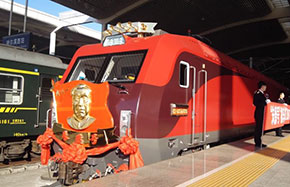Economy is tale of two growth rates
Two-speed system unavoidable for now as China undergoes major transition
China's recent economic development, especially with the seemingly reduced growth as indicated by the GDP, has attracted tremendous attention and heated discussion.
The country has recently applied a list of policy and strategies such as the Belt and Road Initiative, Asian Infrastructure Investment Bank and the New Development Bank to equip China's transition. The fundamental principle of this transition is to rebalance the economy between various extreme contrasts, and to move China from an investment-based economy to a repositioned economy driven by domestic consumption.
A two-speed economy in this revolutionary process is an unavoidable stage.
Allowing a two-speed economy to exist and evolve in the economic transition is hardly a choice, more a must. A two-speed economy is a process of accepting and adjusting two contrasting parties (such as regions and sectors) with different development models, speed, strategies and economic performance.
This phenomenon is not new; it has existed in China for the past 30 years. The challenges have been always with local authorities, stakeholders and communities in their decision-making, policymaking, and strategy design and execution. Over a long period, a two-speed economy was essentially a dual economy in China, with major contrasts in growth between the urban, eastern and manufacturing parts (high speed) and the rural, western and service sectors (low speed).
This transition is more likely represented by a switch from an investment-driven economic development model to a consumption-driven rebalanced model.
Its challenges have been puzzling. First, is China able to move out of an upper-middle-income trap and integrate into the club of upper-income nations? Second, is China able to improve its people's quality of life and happiness (with affordable and reliable healthcare, clean air, safe and sufficient water and food supplies, competitive and balanced education), in addition to rapidly improving income per capita?
To respond to these issues at a national level, China requires a new form of two-speed economy.
The recent transition trajectory is about structural changes, such as:
The rapidly increasing contribution of the service sector to China's economic growth (nearly 50 percent in recent quarters) and the reduced economic power of manufacturing (down from 46 percent in 2010 to 42 percent in 2013);
the growing power from western inland regions compared with the slowdown of economic counterparts in eastern developed regions;
the mixed formula with a fast-growing service sector from the eastern developed regions, in contrast to fast-growing manufacturing in the western developing regions with an ascending position in the value chain;
the shrinking wealth gap between regions, with the new housing registration policy to give workers (higher and lower skilled) greater mobilization and immigration.
The emergence of the service sector is a major characteristic in this two-speed economy. By the end of last year, tourism revenues increased 14 percent, theater box office returns 33.7 percent, financial services revenues 15 percent, and sports services revenues 20 percent.
The fast growth of the service sector has dramatically altered China's previous economic model, which relied heavily on investment (down from more than 45 percent of GDP in 2007 to 11 percent last year). According to the economics of entrepreneurship, we can argue that the rapidly increasing contribution from the service sectors over recent years resulted from the increased human capital in terms of its quality and quantity, measured by the high numbers of university graduates, higher wage levels of labor, as well as higher employment ratios.
This is also an essential condition for China to promote mass entrepreneurship and innovation, another economic transition policy.
However, the new economic balance in China has many challenges and expectations. Some industries will suffer and decline - steel, for example - while others will be boosted on the back of domestic demand, innovation, government policy and regulation.
A quantitative measure (such as GDP growth rate) is obviously not sufficient to evaluate and foresee a transitional nation's growth power. An integrative index for the quantity and quality of a dynamically changing structured two-speed economy is called for. The application of this new index also must be closely monitored and guided, in addition to just simply letting the market drive the transitional navigation.
The author is an associate dean of China business and relations at Erasmus University's Rotterdam School of Management.


















